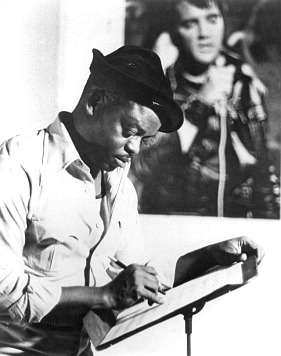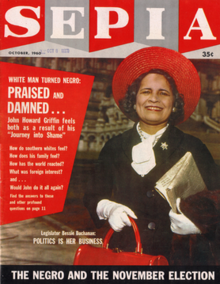
Elvis Aaron Presley, often referred to mononymously as Elvis, was an American singer and actor. Dubbed the "King of Rock and Roll", he is regarded as one of the most significant cultural figures of the 20th century. Presley's energized interpretations of songs and sexually provocative performance style, combined with a singularly potent mix of influences across color lines during a transformative era in race relations, led him to both great success and initial controversy.

An Elvis impersonator is an entertainer who impersonates or copies the look and sound of American musician and singer Elvis Presley. Professional Elvis impersonators, commonly known as Elvis tribute artists (ETAs), work all over the world as entertainers, and such tribute acts remain in great demand due to the unique iconic status of Elvis. There are even several radio stations that exclusively feature Elvis impersonator material. Some of these impersonators go to Graceland on the anniversary of Presley's death to make their personal tribute to the artist.

Otis Blackwell was an American songwriter whose work influenced rock and roll. His compositions include "Fever", "Great Balls of Fire" and "Breathless", "Don't Be Cruel", "All Shook Up" and "Return to Sender", and "Handy Man".

John Howard Griffin was an American journalist and author from Texas who wrote about and championed racial equality. He is best known for his 1959 project to temporarily pass as a black man and journey through the Deep South in order to see life and segregation from the other side of the color line first-hand. He first published a series of articles on his experience in Sepia magazine, which had underwritten the project, then later published an expanded account in book form, under the title Black Like Me (1961). This was later adapted into a 1964 film of the same name. A 50th anniversary edition of the book was published in 2011 by Wings Press.

"All Shook Up" is a song recorded by Elvis Presley, published by Elvis Presley Music, and composed by Otis Blackwell. The single topped the U.S. Billboard Top 100 on April 13, 1957, staying there for eight weeks. It also topped the Billboard R&B chart for four weeks, becoming Presley's second single to do so, and peaked at No. 1 on the country chart as well. It is certified 2× platinum by the Recording Industry Association of America.

Sun Studio is a recording studio opened by rock-and-roll pioneer Sam Phillips at 706 Union Avenue in Memphis, Tennessee, on January 3, 1950. It was originally called Memphis Recording Service, sharing the same building with the Sun Records label business. Sun Studio is perhaps most famous for its role in the early years of Elvis Presley’s career.

Walter Dewey Redman was an American saxophonist who performed free jazz as a bandleader and with Ornette Coleman and Keith Jarrett.

"Don't Be Cruel" is a song that was recorded by Elvis Presley and written by Otis Blackwell in 1956. It was inducted into the Grammy Hall of Fame in 2002. In 2004, it was listed #197 in Rolling Stone's list of 500 Greatest Songs of All Time. The song is currently ranked as the 173rd greatest song of all time, as well as the sixth best song of 1956, by Acclaimed Music.
White nigger, sometimes shortened to wigger, is an ethnic slur with different meanings in different parts of the English-speaking world.

The Messenger was an early 20th-century political and literary magazine by and for African-American people in the United States. It was important to the flowering of the Harlem Renaissance and initially promoted a socialist political view. The Messenger was co-founded in New York City by Chandler Owen and A. Philip Randolph in August 1917.

Since the beginning of his career, American singer Elvis Presley has had an extensive cultural impact. According to Rolling Stone, "It was Elvis who made rock 'n' roll the international language of pop." The Rolling Stone Encyclopedia of Rock & Roll describes Presley as "an American music giant of the 20th century who single-handedly changed the course of music and culture in the mid-1950s". His recordings, dance moves, attitude and clothing came to be seen as embodiments of rock and roll. His music was heavily influenced by African-American blues, Christian gospel, and Southern country. In a list of the greatest English language singers, as compiled by Q magazine, Presley was ranked first, and second in the list of greatest singers of the 20th century by BBC Radio. Some people claim that Presley created a whole new style of music: "It wasn't black, wasn't white, wasn't pop or wasn't country—it was different." He gave teens music to grow up with and listen to, as most singers in his time created music geared for adults.

Butler Place Historic District is a 42-acre area east of the central business district of Fort Worth, Texas. From about 1940-2020, it was a public housing development with 412 units. The site is now to be dedicated to a new purpose, perhaps a museum focused on African Americans in Fort Worth's history.

William Arthur Smith, known as Major Bill Smith, was an American record producer, publisher, promoter, songwriter, and record label owner based in Fort Worth, Texas.
Ripley A. Arnold (1817–1853) was a major in the United States Army and founder of Camp Worth in 1849, later renamed Fort Worth, Texas. In 2014 a 22-foot statue was dedicated to Arnold. It was erected along the Trinity River below the army camp site he established and named after one of his military commanders.

Lovett Huey Fort-Whiteman was an American political activist and Communist International functionary. Fort-Whiteman died of malnutrition while imprisoned in the USSR. The first black American to attend a Comintern training school in the Soviet Union in 1924, Fort-Whiteman was later named the first national organizer of the American Negro Labor Congress, a mass organization of the Communist Party, USA. Fort-Whiteman was once called "the reddest of the blacks" by Time magazine.
The Dallas–Fort Worth metroplex has 1.2 million African-Americans, the 2nd-largest metro population of African-Americans in Texas.
The Skyliner Ballroom was a nightclub located on Jacksboro Highway in Fort Worth, Texas. It was opened in the late 1930s and operated until 1966. The Skyliner evolved over the years, hosting big bands, jazz, burlesque, blues, and eventually rock & roll acts.
Hearne Academy, founded in 1881, was a school for African Americans during the post-Reconstruction era in Hearne, Texas. It was renamed and relocated in 1909 to become Fort Worth Industrial and Mechanical College in Fort Worth, Texas. It was modeled after Tuskegee Institute. That institution closed in 1929 after struggling financially.

Drake Milligan is an American actor and singer best known for portraying Elvis Presley on the CMT series Sun Records and starred in a film called “Nobody” where he portrayed a young teen Elvis. But more recently, for his appearances on American Idol and America's Got Talent.

33-year-old meatpacker Fred Rouse was lynched on December 11, 1921, in Fort Worth, Texas.














